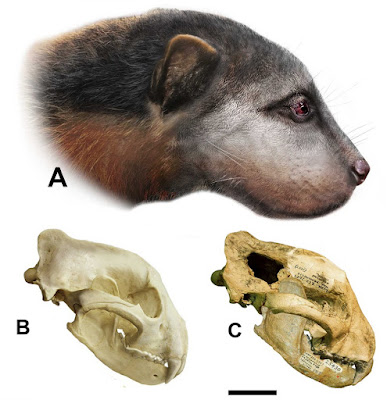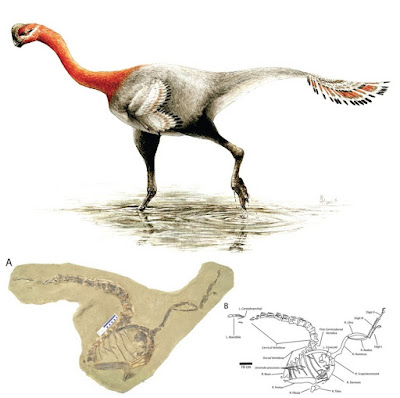[Most Recent Entries] [Calendar View]
Wednesday, April 20th, 2016
| Time | Event | ||||
| 5:27a | [Mammalogy • 2016] Megalictis, the Bone-Crushing Giant Mustelid (Carnivora, Mustelidae, Oligobuninae) from the Early Miocene of North America
Abstract We describe cranial and mandibular remains of three undescribed individuals of the giant mustelid Megalictis ferox Matthew, 1907 from the latest Arikareean (Ar4), Early Miocene mammal fauna of Nebraska, and Wyoming (USA) housed at the American Museum of Natural History (New York, USA). Our phylogenetic hypothesis indicates that Ar4 specimens assigned to M. ferox constitute a monophyletic group. We assign three additional species previously referred to Paroligobunis to Megalictis: M. simplicidens, M. frazieri, and “M.” petersoni. The node containing these four species of Megalictis and Oligobunis forms the Oligobuninae. We test the hypothesis that Oligobuninae (Megalictis and Oligobunis) is a stem mustelid taxon. Our results indicate that the Oligobuninae form the sister clade to the crown extant mustelids. Based on the cranium, M. ferox is a jaguar-size mustelid and the largest terrestrial mustelid known to have existed. This new material also sheds light on a new ecomorphological interpretation of M. ferox as a bone-crushing durophage (similar to hyenas), rather than a cat-like hypercarnivore, as had been previously described. The relative large size of M. ferox, together with a stout rostrum and mandible made it one of the more powerful predators of the Early Miocene of the Great Plains of North America.
Alberto Valenciano, Jon A. Baskin, Juan Abella, Alejandro Pérez-Ramos, M. Ángeles Álvarez-Sierra, Jorge Morales and Adam Hartstone-Rose. 2016. Megalictis, the Bone-Crushing Giant Mustelid (Carnivora, Mustelidae, Oligobuninae) from the Early Miocene of North America. PLoS ONE. DOI: 10.1371/journal.pone.0152430 | ||||
| 5:55a | [Paleontology • 2016] Apatoraptor pennatus • A New Caenagnathid (Dinosauria: Oviraptorosauria) from the Horseshoe Canyon Formation of Alberta, Canada, and A Reevaluation of The Relationships of Caenagnathidae ABSTRACT Our understanding of caenagnathids has benefited from recent discoveries, including nearly complete skeletons from the Hell Creek Formation of Montana. However, their phylogenetic relationships remain unclear. A new specimen from the Horseshoe Canyon Formation of Alberta has implications for the phylogeny and paleobiology of these creatures. The partial skeleton is articulated and includes a mandible, a full cervical and dorsal series of vertebrae, a right pectoral girdle and arm, a sternum, gastralia, a partial ilium, and a partial hind limb. The mandible is edentulous and the articular ridge is intermediate in form between Caenagnathus collinsi and Chirostenotes pergracilis. The neck is long and composed of at least 11 well-pneumatized cervical vertebrae with fused cervical ribs. The dorsal ribs have finger-like uncinate processes dissimilar in shape to those of other oviraptorosaurs. The pectoral girdle is large and typically maniraptoran, except that the glenoid of the scapulocoracoid faces laterally instead of posteroventrally. The arm is well muscled and can be interpreted to have been a pennibrachium, as indicated by ulnar papillae on the ulna. The manus is characterized by a short first metacarpal but an elongate phalanx I-1 and oviraptorid-like phalangeal proportions in the second digit. These and other features indicate that the specimen represents a new taxon, Apatoraptor pennatus, gen. et sp. nov. Phylogenetic analysis resolves the complicated relationships of Caenagnathidae and allows the evolution of display features to be traced throughout Oviraptorosauria.
Gregory F. Funston and Philip J. Currie. 2016. A New Caenagnathid (Dinosauria: Oviraptorosauria) from the Horseshoe Canyon Formation of Alberta, Canada, and A Reevaluation of The Relationships of Caenagnathidae. Journal of Vertebrate Paleontology. DOI: 10.1080/02724634.2016.1160910 Deceptive feathered dinosaur finally gets a name http://phy.so/380183795 via @physorg_com Dinosaur's special arm muscles likely used to flex feathers in mating display http://www.cbc.ca/1.3536313 |
| << Previous Day |
2016/04/20 [Calendar] |
Next Day >> |





